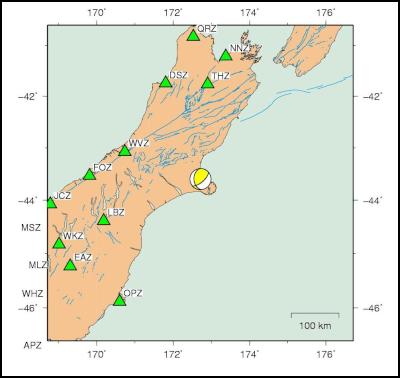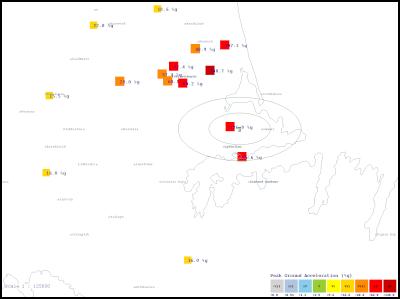Christchurch badly damaged by magnitude 6.3 earthquake
Feb 22 2011 - Christchurch badly damaged by magnitude 6.3 earthquake
Christchurch has experienced a major earthquake centred south of the city, and severe damage and casualties have been reported.

Click for big version
The earthquake has a reverse faulting mechanism (yellow beachball), The stations used to derive it are shown by the green triangles.

Click for big version
Map showing measured Peak Ground Accelerations in the Christchurch area.
Last
updated February 23, 7:00 am
• Receive notification of all website
updates on your mobile via Twitter
• View our map of the latest
aftershocks in the area
• Follow
the shaking: across the country or at the nearby McQueen's
Valley seismograph
• Read the list of the most recent
aftershocks
• Make your personal earthquake report
for the magnitude 6.3 Christchurch
earthquake
The city had been comparatively lucky with both the location and timing of last September's magnitude 7.1 Darfield (Canterbury) earthquake; the location of this one within 10 km of the city and at a shallow depth of 5 km during the middle of a working day has resulted in destruction, injuries and deaths.
Shaking intensity in the city was much greater for this earthquake than the magnitude 7.1 earthquake for any of its other aftershocks. The highest shaking was recorded at Pages Road Pumping Station at 188 %g, with readings of 127 %g at Heathcote Valley Primary School and 107 %g at Hulverstone Road Pumping Station. This is due to the proximity of the epicentre to the city and the shallow depth.
Seismologically, this is classed as an aftershock because of its relationship to the ongoing activity since September last year. Its occurrence was always statistically possible, but the long time interval and slow decrease in general activity had made it less likely. Unfortunately, it has happened after all and in a location that has brought the worst result.
ENDS


 Bill Bennett: Australian warship takes rural fixed wireless broadband offline
Bill Bennett: Australian warship takes rural fixed wireless broadband offline NZ Telecommunications Forum - TCF: New Zealand Is Saying Goodbye To 3G: Are You Ready For The Change?
NZ Telecommunications Forum - TCF: New Zealand Is Saying Goodbye To 3G: Are You Ready For The Change? NZ Post: Mānawatia A Matariki - NZ Post Stamps Look To The Stars Ahead Of The Māori New Year
NZ Post: Mānawatia A Matariki - NZ Post Stamps Look To The Stars Ahead Of The Māori New Year Waipa Networks: Cambridge Is Open For Business With $45M Energy Boost
Waipa Networks: Cambridge Is Open For Business With $45M Energy Boost Master Plumbers Gasfitters and Drainlayers NZ: New Consumer NZ Test Reveals Danger Of Unregulated Online Plumbing Products
Master Plumbers Gasfitters and Drainlayers NZ: New Consumer NZ Test Reveals Danger Of Unregulated Online Plumbing Products Mindful Money: Winners At The Mindful Money Annual Ethical & Impact Investment Awards 2025
Mindful Money: Winners At The Mindful Money Annual Ethical & Impact Investment Awards 2025


